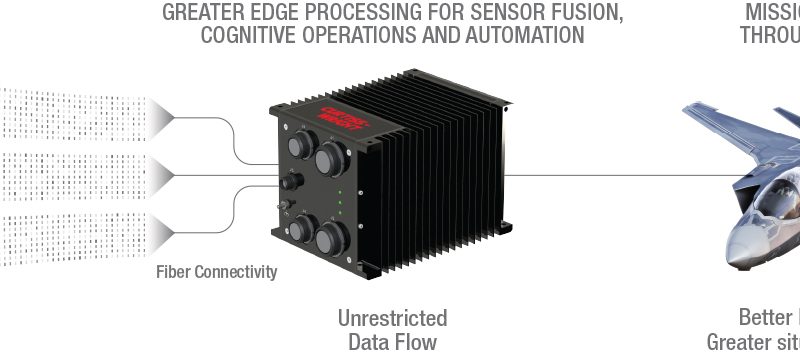Curtiss-Wright Unveils its Strategic Vision for 25 Gbaud “Gen 5” OpenVPX Products for Next Generation 100G Systems
Next-generation Fabric100™ 3U and 6U modules and systems will support 100Gbit Ethernet and PCIe Gen 4 to eliminate processing chain bottlenecks.
Curtiss-Wright’s Defense Solutions division announced the launch of its new Fabric100 suite of 3U and 6U OpenVPX™ modules and systems. Fabric100 brings 100Gbit Ethernet, and high-performance PCIe Gen4 interconnect speeds to tomorrow’s new generation of rugged deployable computing architectures. Today, system integrators must satisfy their C5ISR applications’ insatiable appetite for sharing ever-increasing volumes of information. The higher-speed interconnects required to support these performance demands introduce significant integration challenges for systems integrators. What’s more, the ability to meet the industry’s goal of simplified interoperability, in other words, to quickly and effectively build systems using open standards-based building blocks and make them work well together, becomes increasingly risky as system designers migrate to faster 16Gbaud and 25Gbaud signaling technology. To address this daunting problem and reduce the system design risks associated with higher-speed interconnects, Curtiss-Wright has developed Fabric100, a complete end-to-end ecosystem of high-speed rugged OpenVPX modules and system components. It is not enough to provide 100Gbit connections between a system’s modules yet fail to support the ability to process all this data within the modules. Recognizing that Curtiss-Wright’s Fabric100 board architectures are designed to deliver full 100Gbit performance through the entire processing chain to effectively eliminate data bottlenecks that might otherwise compromise system performance.
The first members of the Fabric100 family, which will feature 3U and 6U modules, will be publicly announced throughout 2023. The debut products in the Fabric100 family, a pair of multi-processing 6U OpenVPX modules, will include a dual-processor compute module and a dual-processor signal acquisition and processing module.
Support for SOSA Architectures
For customers building systems based on the SOSA Technical Standard, all Fabric100 products are designed to align with the SOSA Technical Standard, including I/O Intensive Single Board Computer Profile modules, Payload/Compute Profile modules, and several Switch profile modules. Customers that don’t require alignment with SOSA will also benefit from Fabric100 innovations since the SOSA standard’s common pinouts and Curtiss-Wright’s adherence to specific SOSA profiles for all Fabric100 3U and 6U modules will help deliver unprecedented levels of systems integration ease and greater flexibility and options for future technology insertions.
A Seamless Upgrade Path from 40Gbit to 100Gbit
For customers currently using Curtiss-Wright Fabric40™ OpenVPX technology with 40Gbit interconnect speeds, the new Fabric100 solutions will provide a simplified technology insertion path. As Fabric40 and Fabric100 products share considerable architectural hardware and software commonality, customers that plan to deploy Fabric100-based designs can begin their system development using Fabric40 hardware and upgrade later as needed, with only minimal systems and application design updates required. Customers will also benefit from having a single vendor that provides a consistent development ecosystem, including platform software and application APIs, to ease their transition from 40Gbit to 100Gbit processing.
Designed to provide system designers with unmatched interoperability, the Fabric100 suite of products will address the broadest range of rugged deployed applications, from those that require low power and high-efficiency general-purpose processing (GPP) to those that demand the most extreme and compute-intensive processing performance. The Fabric100 family will enable system designers to architect their entire system, whether they require GPP or High-Performance Embedded Computing (HPEC), Virtualization, AI/ML Engines, GPU acceleration, or Programmable FPGA Processors, all while using members of the same product suite which have been optimized to work seamlessly together. Curtiss-Wright ensures that the benefits of this high-speed technology are realized by systems integrators with the verification of the 100Gbit throughput performance of Fabric100 products, not just at the interface or module level but when used together at the system level. To support and validate Fabric100’s 25 Gbaud interconnects, Curtiss-Wright has developed the industry’s most rigorous 25 Gbaud signal integrity design rules for system-level integration.
New and Innovative Module-level Thermal Management
Predictably, faster signaling technology in Gen 5 OpenVPX systems drives increased power and thermal dissipation requirements. As the industry moves to 100W, 150W, 200W, and even 300W modules, the ability to cool contemporary processing engines becomes a critical differentiator between competing COTS vendors. While two suppliers may use the same or similar processing chipsets, the design that uses a better thermal solution will deliver superior operational performance. For that reason, Curtiss-Wright has implemented new and innovative module-level thermal management techniques that provide excellent cooling for COTS versions of its Fabric100 product suite. In addition, a wide range of advanced chassis-level cooling methods is also supported by the Fabric100 product suite, including Air Flow-Thru (AFT), Liquid Flow-Thru (LFT), and Fluid Flow-Thru (FFT) technologies.

